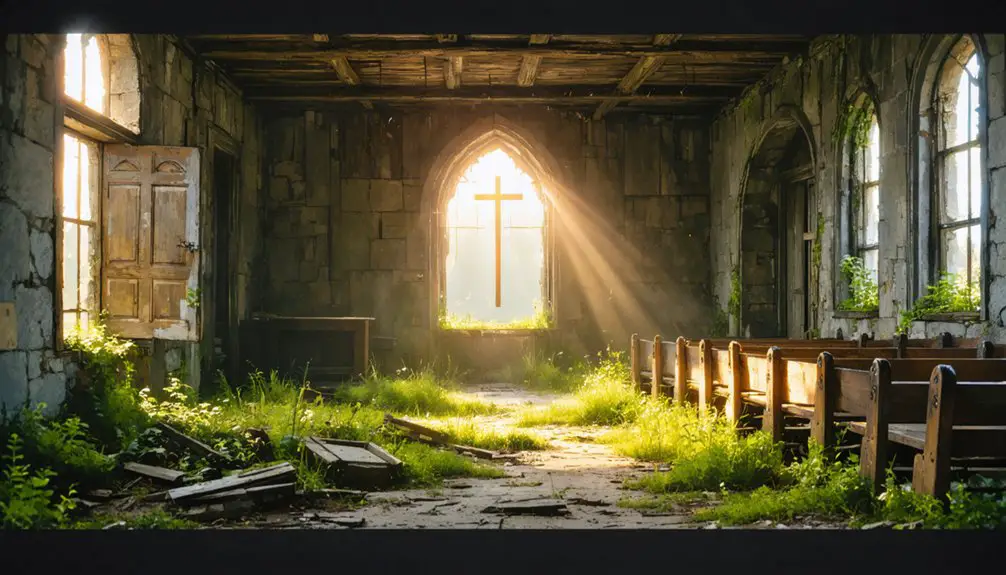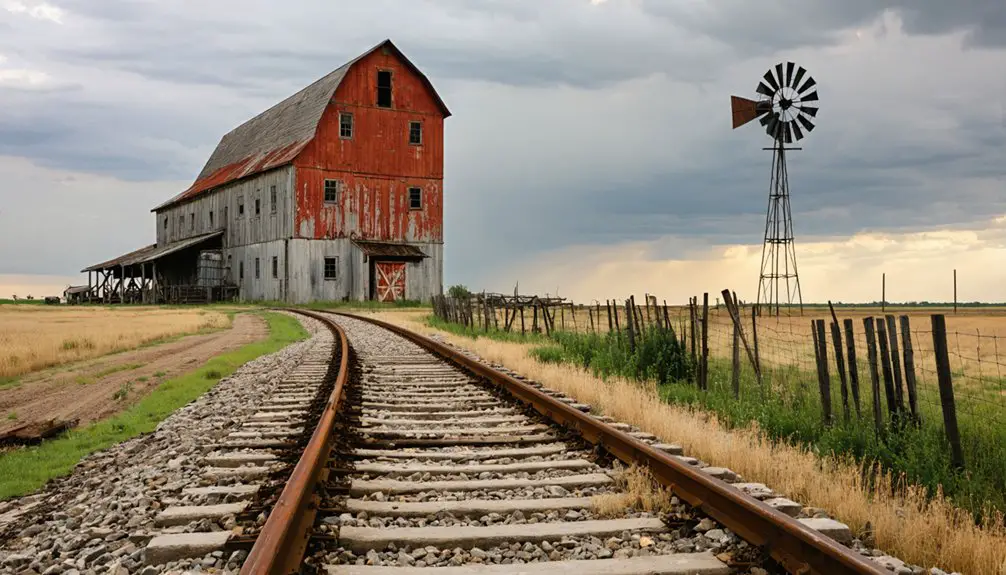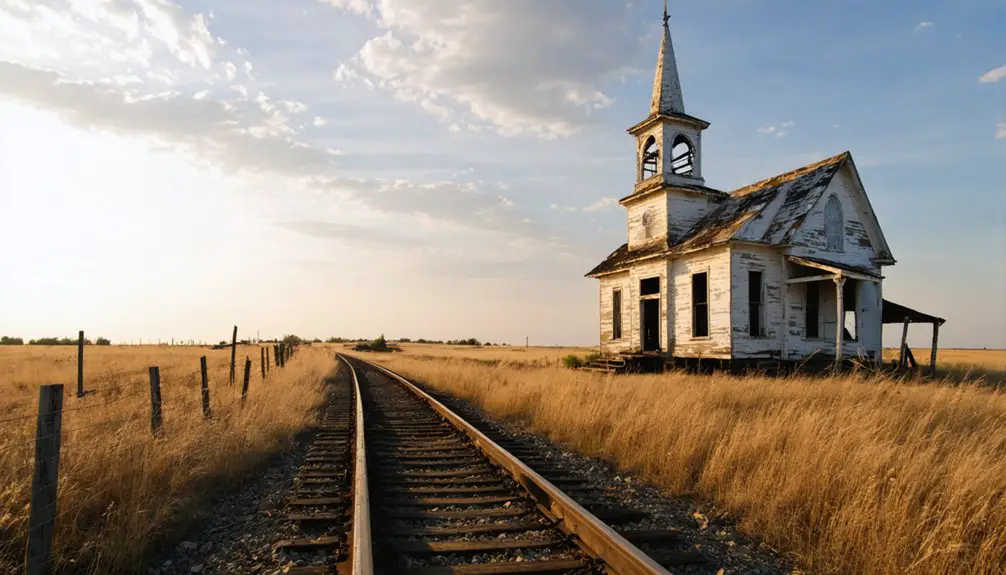You’ll find Saxman in Rice County, Kansas, where it emerged in 1888 along the Frisco Railroad. The town quickly developed with DeWeese’s store, a post office, and a lumberyard serving local farmers. Community life flourished around the United Presbyterian Church built in 1906 and a renowned 35-member brass band that once performed for President Taft. Though the post office closed in 1952, Saxman’s historic buildings and railroad legacy hold fascinating tales of Kansas’s rural past.
Key Takeaways
- Saxman is a former railroad town in Rice County, Kansas, founded in 1888 alongside the Frisco Railroad line.
- The town’s decline began with the post office closure in 1952, leaving only 30 residents in present day.
- Historic landmarks include the 1906 United Presbyterian Church, which remains standing and undergoes preservation efforts.
- The community thrived on agriculture and railroad commerce, featuring a grain elevator, lumberyard, and various commercial establishments.
- The ghost town preserves early commercial buildings and houses from the 1900s, alongside unused Frisco Railroad tracks.
The Birth of a Railroad Town
When the Frisco Railroad expanded through Rice County, Kansas in 1888, it sparked the founding of Saxman on a quarter section of land named after its original owner. The railroad expansion transformed this empty stretch of prairie into a bustling frontier settlement, with streets carefully aligned parallel and perpendicular to the tracks for maximum efficiency.
You’d have found the early signs of community dynamics taking shape around George DeWeese’s store, which served as the town’s first commercial establishment. While inventory was limited, it drew customers from miles around. Joe Bleger managed both the Frisco station and post office duties for nearly two decades.
The railroad station became the heart of daily life, where you could catch a train, pick up supplies, or exchange news with neighbors. Like many Kansas railroad towns, Saxman would eventually face significant population decline as rail transportation diminished. Regular church gatherings and the construction of Woodman Hall soon followed, creating the social fabric that would bind this new railroad town together.
Life in Early Saxman
You’d find early Saxman’s community life centered around impromptu religious gatherings initially held in the elevator driveway, where worshippers made do with makeshift seating despite the occasional disruption from rats.
Archaeological studies have revealed that the area was once home to the Great Bend village, offering insights into earlier Native American settlements.
Much like Reverend R.P. West preaching the first sermon in Clay County, these early spiritual services helped unite the growing community.
The town’s social calendar expanded when the Woodman Hall opened, serving double duty as both a Friday night dance venue and Sunday church space.
Early Religious Gatherings
As Saxman emerged alongside the Frisco Railroad in 1888, its earliest religious services took place in the modest setting of the grain elevator’s driveway, where worshippers sat on bricks balanced across nail kegs.
Despite pesky rats that disrupted services and startled women, the pioneer resilience of these early settlers remained unshaken. Like many Kansas settlers who exhibited strong religious presence, these early Saxman residents were determined to maintain their spiritual practices despite challenging conditions. Their commitment to faith reflected a growing cultural shift toward demanding communities rather than casual gatherings.
The congregation soon moved to Woodman Hall, which exemplified the town’s practical approach to community identity.
You’d find the hall transformed from a Friday night dance venue to a Sunday morning church, welcoming both “saints and sinners” without conflict.
In 1906, the United Presbyterian Church building was constructed, marking a significant milestone.
Joe Bleger, who managed both church and elevator operations, helped establish this more permanent home for Saxman’s religious gatherings.
Band Performance Highlights
The inception of Saxman’s renowned band came through a visionary grain buyer and former bandleader who established the town’s first brass ensemble in the early 1900s.
Starting in the depot baggage room, the band quickly grew to 35 members by 1907, offering traditional band repertoire that resonated throughout the region. Their performances often incorporated march music that reflected the early jazz influences of the time.
You would’ve witnessed the band’s crowning achievement when they were invited to perform for William Howard Taft in Hutchinson during 1907.
As Secretary of War at the time, Taft’s presence elevated the band’s reputation beyond Saxman’s borders. The ensemble became a cornerstone of local culture, performing at numerous community events and establishing itself as the region’s finest musical group.
Despite limited facilities, they exemplified the spirit of small-town Kansas through their musical excellence. The band often performed at the Woodman Hall, which served as a central gathering place for the community’s cultural events.
Commerce and Trade Growth
Beyond the musical vibrancy of early Saxman, commerce took root in 1888 when the Frisco Railroad expanded through Rice County, Kansas. George DeWeese’s one-room store became the first trade hub, drawing customers from surrounding farms. Like many ghost towns across Kansas, the town’s prosperity relied heavily on railroad commerce.
Similar to how Asbury grew with railroads, Saxman’s railroad established crucial trade routes, with Joe Bleger serving as the Frisco agent for 19 years while managing the town’s essential grain elevator.
The railroad established crucial trade routes, with Joe Bleger serving as the Frisco agent for 19 years while managing the town’s essential grain elevator.
You’d find agricultural commerce thriving through Bleger’s initiatives, including the town’s first lumberyard and post office operations. The grain elevator became particularly significant, serving both economic and social functions – even hosting early church services in its driveway.
As trade expanded, Woodman Hall emerged as a multipurpose venue, while the construction of a Presbyterian Church by 1906 signaled the town’s growing prosperity and permanent establishment.
The Famous Brass Band Legacy
In 1907, you’d find Saxman’s vibrant brass band practicing in the depot baggage room, where they grew into a formidable 35-piece ensemble recognized as the finest in their section of Kansas.
The band’s excellence earned them a prestigious invitation to perform for Secretary of War William Howard Taft during his visit to Hutchinson, Kansas that same year.
Saxman’s brass band brought significant pride to this small agricultural town, transforming the community into a cultural beacon that drew admiration from across the region.
Town’s Musical Pride
Shortly after Saxman’s establishment in 1888, a local grain buyer and experienced bandleader founded what would become one of Kansas’s most prestigious brass bands. This 35-piece ensemble quickly became the cornerstone of Saxman’s musical heritage, overcoming initial challenges like finding rehearsal space until securing the depot baggage room.
Through dedicated community engagement, the band flourished into the region’s finest musical group.
- Performed for William Howard Taft during his tenure as Secretary of War
- Featured brass instrumentation that set the standard for small Kansas towns
- Earned recognition as the best band in their section of Kansas
- Received coveted invitation to perform in Hutchinson in 1907
- Provided musical entertainment for local events and social gatherings
Your town’s pride lived on even after Saxman’s decline, remaining a reflection of the community’s cultural spirit and determination.
Taft’s Special Performance
When Secretary of War William Howard Taft visited Kansas in 1906, Saxman’s renowned brass band seized a prestigious opportunity to perform during his campaign tour.
You’ll find that brass band performances were an essential part of Taft campaigns, serving both entertainment and political purposes. The band played patriotic songs and campaign anthems from their position on touring cars, engaging crowds during open-air addresses.
They’d coordinate with Taft’s team to maximize the impact of each appearance, playing regional favorites that resonated with local audiences.
This special performance wasn’t just about music – it demonstrated how brass bands helped shape political messaging and community unity in the early 20th century.
Saxman’s participation in this tradition left an enduring mark on the region’s cultural heritage, even after the town’s decline.
Religious and Cultural Heritage

Religious life in Saxman began humbly, with the first worship services held outdoors near the grain elevator using makeshift seating of bricks and nail kegs.
When rats disrupted these gatherings, services moved to Woodman Hall, which uniquely served as both a dance hall and church. This dual-purpose venue strengthened community cohesion as townspeople gathered for both spiritual and social activities.
By 1906, you’d find the United Presbyterian Church standing as a symbol of Saxman’s growing cultural identity.
The United Presbyterian Church rose in 1906, embodying the hopes and aspirations of a young prairie town seeking its place.
- The church anchored community life even as the town’s population declined
- A 35-piece band by 1907 showcased the town’s vibrant cultural scene
- The Presbyterian building remains a significant historical landmark
- Local resident Dale Hoover led preservation efforts
- The church adapted to serve both religious and social functions
Economic Rise and Fall
While spiritual life flourished in early Saxman, the town’s economy centered firmly on agriculture and local commerce in the early 1900s.
You’d find a bustling grain trade managed by a local buyer who doubled as the town’s bandleader, while the railway depot served as an essential hub for business and community gatherings.
The town’s economic sustainability relied on its role as a modest service point, featuring a post office, school, and various local businesses.
However, by the mid-20th century, Saxman couldn’t escape the rural depopulation trends affecting Kansas.
The 1952 closure of the post office marked the beginning of a steady decline, as key community figures departed and basic services vanished.
Without industrial opportunities to diversify its economy and facing diminishing railway relevance, Saxman’s fate was sealed.
Landmarks and Remnants Today

Despite decades of abandonment, several historic structures still stand as silent witnesses to Saxman’s past.
You’ll find the 1906 United Presbyterian Church undergoing landmark restoration by Dale Hoover, while scattered early 20th-century houses and commercial buildings dot the landscape. The old Frisco Railroad tracks cut through town, though they’re now unused and overgrown.
The historic United Presbyterian Church rises amid Saxman’s quiet streets, a testament to preservation amid fading buildings and dormant rail lines.
- Former United Presbyterian Church remains the most prominent structure, showcasing historical preservation efforts
- Remnants of the grain elevator site mark what was once the town’s economic center
- Original street layouts remain visible from aerial views
- Brick-lined church seating foundations reveal early worship locations
- Railroad artifacts, including old ties and loading platforms, trace Saxman’s industrial heritage
While most structures face decay, local volunteers continue working to preserve these remaining pieces of Kansas history.
Ghost Town’s Place in Kansas History
Established in 1888 along the expanding Frisco Railroad line, Saxman represents a quintessential Kansas ghost town that mirrors the broader narrative of the state’s rural development and decline.
You’ll find its historical significance reflected in the familiar pattern of many Kansas ghost towns – born from railroad expansion, sustained by agriculture, and eventually diminished by technological progress.
Like countless other rural communities, Saxman’s story unfolds through the rise and fall of local commerce, highlighted by its renowned 35-piece brass band that once performed for future President Taft.
The town’s gradual decline, marked by its post office closure in 1952, wasn’t triggered by a single catastrophic event but rather by the shifting tides of transportation needs and agricultural mechanization.
Today, with just 30 residents, it stands as a monument to the evolution of rural Kansas.
Frequently Asked Questions
What Happened to the Original Saxman Family After Founding the Town?
You won’t find clear records of the Saxman legacy or founding family after the town’s establishment. Their fate remains a mystery, as historical documents don’t track their activities beyond initial land ownership.
Were There Any Notable Crimes or Incidents in Saxman’s History?
Unlike tales of unsolved mysteries or ghost sightings you’d expect in an old town, you won’t find notable crimes in Saxman’s history – records show it was remarkably peaceful throughout its existence.
How Did Local Native American Tribes Interact With Saxman’s Early Settlers?
You’ll find evidence of cultural exchange between settlers and Native Americans, particularly the Kaw tribe, through trade agreements, though tensions rose over land disputes and reservation boundary violations near Cow Creek.
What Was the Highest Recorded Population of Saxman During Its Peak?
Like many frontier dreams, you’ll find Saxman’s exact peak population wasn’t officially recorded, but population trends and demographic shifts suggest it likely reached between 300-500 residents at its railroad-era height.
Did Saxman Have Any Unique Local Customs or Annual Celebrations?
You’d find Saxman’s local traditions centered around their acclaimed brass band performances, church gatherings at Woodman Hall, and informal community events, though no specific harvest festival or unique annual celebrations were documented.
References
- http://kansasghosttowns.blogspot.com/2012/08/
- http://kansasghosttowns.blogspot.com/2012/08/saxman-town-in-rice-county.html
- https://www.youtube.com/watch?v=5UTFd2JlelY
- https://legendsofkansas.com/kansas-ghost-town-list/
- https://www.pinterest.com/pin/48202658498975254/
- https://www.youtube.com/watch?v=JvCecTIBmFI
- https://www2.ljworld.com/news/2012/jul/15/times-changes-demise-kansas-town-saxman/
- https://sites.rootsweb.com/~ksricehp/history/1912gaz.html
- https://en.wikipedia.org/wiki/Rice_County
- https://legendsofkansas.com/clay-county-kansas/



